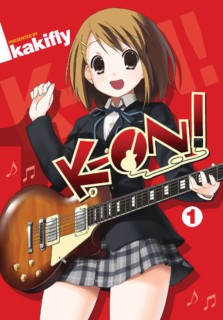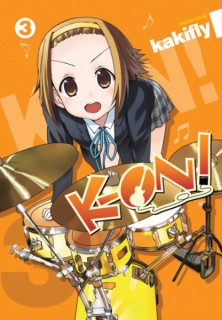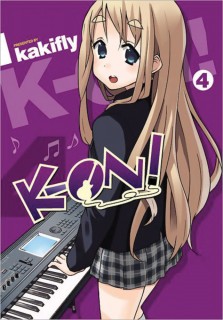K-ON! Manga Review
けいおん!Manga Review
***MILD SPOILERS***
 As a long time anime and manga fan, I’m often made aware of a lot of titles to watch and read. I don’t remember if K-ON was recommended to me or not, but I used to see a ton of images for it while cruising anime websites (Japanese and U.S.) or from social media. As usually happens, I had an online order that needed some filler to make it hit the free shipping threshold, so I decided to get the four K-ON volumes and see what it was all about.
As a long time anime and manga fan, I’m often made aware of a lot of titles to watch and read. I don’t remember if K-ON was recommended to me or not, but I used to see a ton of images for it while cruising anime websites (Japanese and U.S.) or from social media. As usually happens, I had an online order that needed some filler to make it hit the free shipping threshold, so I decided to get the four K-ON volumes and see what it was all about.
In brief, K-ON is primarily a 4-koma manga (comic strip) with an occasional, traditional manga chapter. The four volumes of the manga cover the three years of high school for four of the Pop Music Club members who save the club by joining in their first year — Ritsu (drums), her childhood friend Mio (bass), the sheltered ojousama Mugi (keyboard), and the airhead Yui (guitar). Although they do form a band and play music, primarily, they lounge around, drink the expensive tea that Mugi makes, and eat the expensive snacks Mugi provides. In their second year, they are joined by Azusa, who’s a dedicated guitar player and has a hard time dealing with the very laid back attitude of the club.
 As might be expected, K-ON is a slice of life title as we follow the girls becoming fast friends as well as band mates. A lot of the humor stems from things like Yui being an airhead (and depending on her little sister, Ui), or the club sponsor Sawako-sensei (who was a club member in her high school days) trying to get the girls into some costume or otherwise not acting like a good teacher, or Mio getting embarrassed, or Mugi using her ojousama status to help the club while trying to be casual about that aspect of her life. None of this humor had me laughing out loud, but I did smile a lot and chuckled from time to time.
As might be expected, K-ON is a slice of life title as we follow the girls becoming fast friends as well as band mates. A lot of the humor stems from things like Yui being an airhead (and depending on her little sister, Ui), or the club sponsor Sawako-sensei (who was a club member in her high school days) trying to get the girls into some costume or otherwise not acting like a good teacher, or Mio getting embarrassed, or Mugi using her ojousama status to help the club while trying to be casual about that aspect of her life. None of this humor had me laughing out loud, but I did smile a lot and chuckled from time to time.
I found the stories to be entertaining and the characters to be enjoyable and likable. Because the setting is in a high school, a number of traditional high school tropes appear throughout (exams, school trips, festivals, etc.) the four volumes. This was not a problem for me, even though I’ve read quite a number of manga that is set in high school. Ultimately, K-ON is a manga where one gets on board and just enjoys the ride for the ride’s sake.
As might be expected, things get a little more poignant in the fourth volume of the manga as the girls get ready to graduate and make their plans to go to college. The ending sets up the two spinoff titles, K-ON High School and K-ON College, which I’ll review later.
 While this manga is all about the Pop Music Club and the band After-School Tea Time (Ho-kago Tea Time), I was surprised that the music aspect was more of the glue that held the series together rather than the whole focus. That’s not to say that the musical aspects don’t take a lot of time in the manga, it is just that there was more slice of life stuff than I expected, and that was not a bad thing either.
While this manga is all about the Pop Music Club and the band After-School Tea Time (Ho-kago Tea Time), I was surprised that the music aspect was more of the glue that held the series together rather than the whole focus. That’s not to say that the musical aspects don’t take a lot of time in the manga, it is just that there was more slice of life stuff than I expected, and that was not a bad thing either.
On the Yen Press side of things, major kudos go out for them including all of the color pages. As such, throughout the manga, there are color pages when those chapters were colorized in Japan. Most of the Japanese honorifics are retained, including “oneechan”, but the term “ojousama” had a couple of different translations given to it (though the term is used in the translation notes).
I disagreed with the decision to translate Yui’s method of addressing Azusa as “Azusa-meow” instead of “Azusa-nyan.” While “meow” is the accurate translation of “nyan”, saying “Azusa-nyan” fits better as “nyan” is being used to substitute for “chan” and so flows better in my opinion. A simple translator note explaining the Japanese onomatopoeia of nyan would have sufficed. Plus, I haven’t watched the anime nor read the manga (until now) and I knew that fans called Azusa “Azusa-nyan.”
There were some other odd adaptation choices made. Some better known terms (kotatsu springs to mind, since seeing “heated table” stood out to me) might get translated, but other terms might be left in. However, these things are explained in the translator notes section of the various volumes.
 While I highly approve of the translator notes section, I highly disapprove of how Yen Press handled them. I have NEVER understood why some publishers thing that after reading an entire book “backwards” (by Western standards) that we’d suddenly see straight forward text and go, “Hmmm. Text means must read Western style or universe come to end.” *_* Seriously, you are on page 121 of the manga, then have to skip to page 123 (which Yen press conveniently renames as “page 1” ’cause reasons), go to pages 122, then turn the page and go to page 125, then 124 in order to get the bloody translation notes correctly. Why reverse the flow of the pages just because there’s bloody text? I still have to turn the pages “backwards” to keep with the books’ overall flow, so it makes absolutely no sense to do this whacked way of publishing the translator notes.
While I highly approve of the translator notes section, I highly disapprove of how Yen Press handled them. I have NEVER understood why some publishers thing that after reading an entire book “backwards” (by Western standards) that we’d suddenly see straight forward text and go, “Hmmm. Text means must read Western style or universe come to end.” *_* Seriously, you are on page 121 of the manga, then have to skip to page 123 (which Yen press conveniently renames as “page 1” ’cause reasons), go to pages 122, then turn the page and go to page 125, then 124 in order to get the bloody translation notes correctly. Why reverse the flow of the pages just because there’s bloody text? I still have to turn the pages “backwards” to keep with the books’ overall flow, so it makes absolutely no sense to do this whacked way of publishing the translator notes.
(I still appreciate that translator notes were included though.)
In the end, K-ON manga is a fun little series that was a delight to read. Although it wasn’t anything earth shattering, I did find that this is a world I could return to in order to enjoy the adventures of Mugi, Mio, Tsugumi, Yui, and Azusa.



 August 20th, 2015
August 20th, 2015  AstroNerdBoy
AstroNerdBoy  Posted in
Posted in  Tags:
Tags: 
If you ever get around to watching the anime you may find that the animation adds a more streamlined effect – a greater sense of coherence to the text – making it a teeny bit more propulsive, perhaps; and also a general heightening of the entertainment value, as far as the slapstick goes – and, of course, the music. I don’t remember it as anything exceptional but still – a manga about music is never the same as an anime about music, obviously.
(oh god, this reminds me – I need to go rewatch Nodame, like, yesterday! Gyabo!)
I want to watch the anime for sure. I’ve added it to my LONG list of anime to watch. ^_^;
[…] our musical, female quartet having graduated, it makes sense to have a sequel to the K-ON! manga show our girls in college. Thus we have K-ON! College as one of the two sequels to that original […]